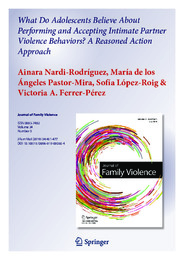Por favor, use este identificador para citar o enlazar este ítem:
https://hdl.handle.net/11000/31336Registro completo de metadatos
| Campo DC | Valor | Lengua/Idioma |
|---|---|---|
| dc.contributor.author | Nardi-Rodríguez, Ainara | - |
| dc.contributor.author | Pastor-Mira, María Ángeles | - |
| dc.contributor.author | López Roig, Sofía | - |
| dc.contributor.author | Ferrer-Pérez, Victoria A. | - |
| dc.contributor.other | Departamentos de la UMH::Ciencias del Comportamiento y salud | es_ES |
| dc.date.accessioned | 2024-02-09T09:26:16Z | - |
| dc.date.available | 2024-02-09T09:26:16Z | - |
| dc.date.created | 2019-05 | - |
| dc.identifier.citation | Journal of Family Violence Volume 34, pages 461–477, (2019) | es_ES |
| dc.identifier.issn | 1573-2851 | - |
| dc.identifier.issn | 0885-7482 | - |
| dc.identifier.uri | https://hdl.handle.net/11000/31336 | - |
| dc.description.abstract | Intimate partner violence against adolescent girls is of increasing political and social concern. This paper presents formative research on the reasoned action approach (RAA) to the prediction of boys’ perpetration and girls’ acceptance of four psychologically abusive behaviors. Our objectives were: (1) to identify the behavioral and normative modal beliefs behind males’ performance and girls’ acceptance of the behaviors and (2) to explore the relationship between attitudes, perceived social norm, intention and behavior. A total of 479 adolescents between 14 and 18 years of age completed questionnaires on the performance (boys) or acceptance (girls) of a specific behavior. We used a grouping process to identify modal beliefs and carried out eight exploratory multiple regression analysis (one per behavior) to study attitude and social norm as predictors of intention and behavior. Positive and negative behavioral beliefs coexist in boys’ and girls’ minds, which can reflect an unclear positioning against abusive behaviors. Positive outcomes seem to be influenced by socialization processes and love myths. Peers can be a risk factor whereas parents are a protective factor against the performance and acceptance of these behaviors. Results showed significant relationships between the constructs in the sense specified by the model. Prevention programs could benefit by: managing participants’ individual behavior, intervening separately with boys and girls, overcoming adolescents’ confusion regarding these behaviors, and targeting parents as a means of discouraging their performance and acceptance. The RAA appears a useful tool for explaining and predicting the performance and acceptance of abusive behaviors | es_ES |
| dc.format | application/pdf | es_ES |
| dc.format.extent | 19 | es_ES |
| dc.language.iso | eng | es_ES |
| dc.publisher | Springer | es_ES |
| dc.rights | info:eu-repo/semantics/openAccess | es_ES |
| dc.rights.uri | http://creativecommons.org/licenses/by-nc-nd/4.0/ | * |
| dc.subject | Prevention | es_ES |
| dc.subject | Adolescence | es_ES |
| dc.subject | Psychological abuse | es_ES |
| dc.subject | Intimate partner violence | es_ES |
| dc.subject | Reasoned action approach | es_ES |
| dc.subject | Beliefs | es_ES |
| dc.subject | Elicitation study | es_ES |
| dc.subject | Evidence-based | es_ES |
| dc.subject.other | CDU::6 - Ciencias aplicadas::61 - Medicina::613 - Higiene en general. Higiene y salud personal | es_ES |
| dc.title | What Do Adolescents Believe About Performing and Accepting Intimate Partner Violence Behaviors? A Reasoned Action Approach | es_ES |
| dc.type | info:eu-repo/semantics/article | es_ES |
| dc.relation.publisherversion | https://doi.org/10.1007/s10896-019-00060-4 | es_ES |

Ver/Abrir:
6-OA-Published Manuscript-JOFV (1).pdf
1,31 MB
Adobe PDF
Compartir:
 La licencia se describe como: Atribución-NonComercial-NoDerivada 4.0 Internacional.
La licencia se describe como: Atribución-NonComercial-NoDerivada 4.0 Internacional.
.png)